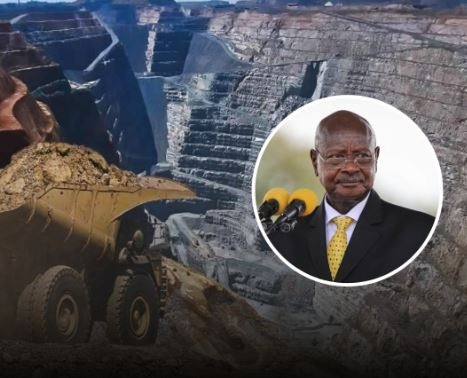Do You Know About Uganda’s $12 Trillion Gold Claim That Shocked the World
In 2022, Uganda announced a jaw-dropping discovery: 31 million tonnes of gold ore (Gold Claim ), worth an estimated US $12 trillion. This article breaks down the details, the skepticism surrounding the numbers, the risks of the resource curse, and what the future might hold.
WORLD & POLITICS
Do You Know Team
8/12/20253 min read


In 2022, Uganda stunned the world with a staggering announcement: geological surveys revealed an estimated 31 million metric tonnes of gold ore — potentially translating to over 320,000 tonnes of pure gold, valued at a jaw-dropping US $12 trillion. If true, this could rival the total gold ever mined in history. But such claims raise serious skepticism. Are these numbers credible? Could Uganda’s economy be transformed — or ensnared in the "resource curse"? Let’s dig deeper.
1. What Exactly Has Uganda Claimed?
The Ugandan Ministry of Energy and Mineral Development reported that a nationwide mix of aerial, geophysical, and geochemical surveys had identified gold ore reserves amounting to about 31 million tonnes. Officials estimated this could yield approximately 320,158 tonnes of refined gold, which at current market rates equals roughly US $12 trillion.
2. Why the Numbers Are Raising Eyebrows
Gold experts and analysts are understandably skeptical. According to the World Gold Council, only about 205,000 tonnes of gold have been mined globally. Current known reserves are estimated to be just ~54,000 tonnes. Uganda’s figures, therefore, suggest a quantity that exceeds the rest of the world combined — a claim that is hard to accept without compelling evidence.
3. The Scientific Red Flags
A key measure here is the gold grade — the concentration of gold per tonne of ore. Uganda’s claim implies a gold grade exceeding 10,000 grams per tonne (g/t), whereas most of today’s high-grade mines operate at around 28 g/t. As one expert bluntly put it:
“At that grade, there would be visible gold absolutely everywhere. You wouldn’t be able to walk without stepping on gold.”
This kind of discrepancy suggests a likely reporting error — perhaps confusing ounces with tonnes — that brings the estimate closer to more realistic levels.
4. What Stakeholders Stand to Gain — or Lose?
Even if just a fraction of the 320,000-tonne figure proves extractable, it could mean tens of billions in revenue — a game-changer for Uganda’s economy. The discovery has already piqued interest from mining investors and intensified talks about infrastructure and refining capacity. But with high reward comes high risk.
5. The Looming Threat of the 'Resource Curse'
History has shown that a sudden windfall from natural resources can lead to mismanagement, corruption, inequality, and conflict — a phenomenon known as the resource curse. Countries like Venezuela and Congo are chilling reminders. Uganda’s institutions could struggle to manage such a discovery without strong governance, transparency, and long-term planning.
6. What Experts Advise for Uganda’s Path Forward
Judicious experts recommend that Uganda take these steps:
Commission rigorous, peer-reviewed geological studies and publish data transparently.
Enhance licensing frameworks, fairness, and anti-corruption measures.
Invest in human capital, infrastructure, and economic diversification.
Ensure local communities receive fair benefits and are protected from displacement or environmental harm.
Frequently Asked Questions (FAQs)
Q1: Is the $12 trillion gold discovery in Uganda confirmed?
No. Uganda’s claims are based on internal surveys and have not been independently verified. Many experts believe the figures are highly inflated or result from calculation errors.
Q2: How does Uganda’s claim compare to global gold totals?
The figure is extraordinarily high — it exceeds both the total mined gold in history (~205,000 tonnes) and current global reserves (~54,000 tonnes).
Q3: What’s wrong with the estimated gold grade?
Uganda’s implied gold grade (10,000 g/t) is wildly unrealistic. Most commercial mines use 10–40 g/t; anything above that would appear visibly gold-laden in the soil.
Q4: Could this discovery help Uganda economically?
If some resources are extractable and managed well, yes. But it’s equally likely that weak governance or corruption could limit the benefits.
Q5: What are the risks of a gold 'rush'?
Uncontrolled mining could lead to environmental damage, social unrest, revenue capture by a few, and hindered economic diversification — classic symptoms of the resource curse.
Conclusion
The notion that Uganda has discovered gold reserves worth US $12 trillion remains — at best — extraordinary, and quite possibly exaggerated. Yet even a modest, responsibly managed portion of these resources could transform the country’s economic trajectory. Careful verification, transparent policies, and inclusive planning are essential if Uganda truly hopes to turn this “gold dream” into sustainable prosperity — rather than a cautionary tale.
#UgandaGoldDiscovery, #GoldMining, #MineralWealth, #AfricanEconomy, #GoldReserves, #MiningNews, #GlobalGoldMarket, #UgandaEconomy, #NaturalResources, #GoldIndustry, #GoldInvestment, #AfricanMining, #PreciousMetals, #EconomicGrowth, #GoldFacts
Knowledge
Empowering minds with reliable educational content daily.
Newsletter Signup
© 2025 DoYouKnow. All rights reserved.
Stay Ahead of the Trends – Join Our Newsletter
